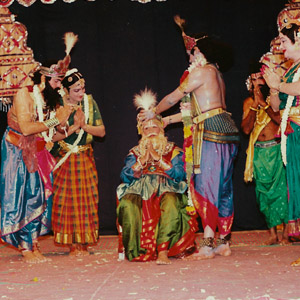For the very first time, this South Indian ritual theatre is being presented to a foreign audience.
Words and sense are the body of poetry; rasa [taste] is its essence.
Bharata, René Daumal, Gallimard
This sacred theatre group is making its first trip beyond the Hindu Temple of Melattur. India was home to some of the first ritual theatre, and this popular form of entertainment is inherited from ancient Sanskrit theatre. It celebrates the god Vishnu and his incarnation Krishna, with more than twenty artists.
This form of theatre from South India is particularly moving. It is one of the last forms of ritual theatre in the sub-continent. The village artists are deeply religious and for them, what counts more than any artistic idea is making the gods come to life, almost incarnating them.
In the village of Melattur in Tamil Nadu, an exciting event takes place each year during the Bhagavata Mela Nataka Festival which falls on the birthday of Lord Narashima, the fourth incarnation of Vishnu. Created by ‘divine anger’, it symbolises the battle against evil and tyranny. It wears a terrifying lion mask and is armed with claws.
The Bhagavata Mela of Melattur is one of the last surviving examples of temple theatre and our only link today with the ancient Sanskrit theatre of Tamil Nadu. The tradition began some four centuries ago with the Hindu religious movement, Bakthi. Other similar forms of theatre still exist elsewhere.
Composed in Telugu by Venkatarama Sastry (1743-1809), the Bhagavata Mela pieces are presented each year in honour of the Natya Shastra vedas. Characters are played exclusively by Brahmin men. The dances, songs and gestures are taught orally and each family plays an hereditary role. Some twenty artists are on stage here for the first time outside their temple.
 Théâtre rituel « Bhagavata Mela »
Théâtre rituel « Bhagavata Mela »